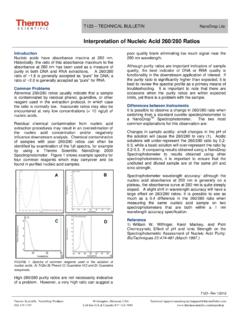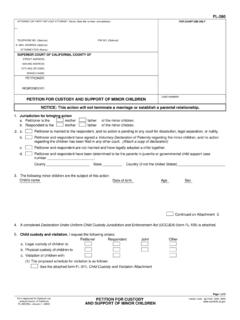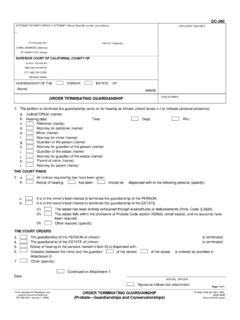Transcription of 260/280 and 260/230 Ratios NanoDrop ND-1000 and ND …
1 T E C H N I C A L S U P P O R T B U L L E T I N T009 260/280 and 260/230 Ratios NanoDrop ND- 1000 and ND-8000 8-Sample Spectrophotometers As absorbance measurements will measure any molecules absorbing at a specific wavelength, nucleic acid samples will require purifi- cation prior to measurement to ensure accurate results. Nucleotides, RNA, ssDNA, and dsDNA all will absorb at 260 nm and contrib- ute to the total absorbance. 260/280 . The ratio of absorbance at 260 nm and 280 nm is used to assess the purity of DNA and RNA. A ratio of ~ is generally accepted as pure for DNA; a ratio of ~ is generally accepted as pure for RNA. If the ratio is appreciably lower in either case, it may indi- cate the presence of protein, phenol or other contaminants that absorb strongly at or near 280 nm. Some researchers encounter a consistent 260/280 ratio change when switching from a standard cuvette spectrophotometer to the NanoDrop ND- 1000 spectrophotometer.
2 The three main explanations for this observation are listed below: CHANGE IN SAMPLE ACIDITY. Small changes in the pH of the solution will cause the 260/280 to vary*. Acidic solutions will under-represent the 260/280 ratio by , while a basic solution will over-represent the ratio by If comparing the ND- 1000 or ND-8000 spectrophotometer to other spectrophotometers, it is important to ensure that the pH of an undiluted sample measured on the ND- 1000 or ND-8000 is at the same pH and ionic strength as the diluted sample measured on the second spectrophotometer. *. William W. Wilfinger, Karol Mackey, and Piotr Chomczynski, Effect of pH and Ionic Strength on the Spectrophotometric Assessment of Nucleic Acid Purity: BioTechniques 22:474-481 (March 1997). WAVELENGTH ACCURACY OF THE SPECTROPHOTOMETERS. Although the absorbance of a nucleic acid at 260 nm is generally on a plateau, the absorbance curve at 280 nm is quite steeply sloped.
3 A slight shift in wavelength accuracy will have a large effect on 260/280 Ratios . C. For example, a +/- 1 nm shift in wavelength accuracy will result in a + change in the 260/280 ratio. Since many spectropho- tometers claim a 1 nm accuracy specification, it is possible to see as much as a difference in the 260/280 ratio when measuring the same nucleic acid sample on two spectrophotometers that are both within wavelength accuracy specification. NUCLEOTIDE MIX IN YOUR SAMPLE. The five nucleotides that comprise DNA and RNA exhibit widely varying 260/280 Ratios **. The following represent the 260/280 . Ratios estimated for each nucleotide if measured independently: Guanine: Adenine: Cytosine: Uracil: Thymine: The resultant 260:280 ratio for the nucleic acid being studied will be approximately equal to the weighted average of the 260/280 . Ratios for the four nucleotides present. It is important to note that the generally accepted Ratios of and for DNA and RNA.
4 Respectively, are "rules of thumb". The actual ratio will depend on the composition of the nucleic acid. Note: RNA will typically have a higher 260/280 ratio due to the higher ratio of Uracil compared to that of Thymine. ** Leninger, A. L. Biochemistry, 2nd ed., Worth Publishers, New York, 1975. NanoDrop and design are registered trademarks of NanoDrop Technologies Wilmington, Delaware USA 2007 NanoDrop Technologies, Inc 2. T E C H N I C A L S U P P O R T B U L L E T I N T009 260/230 . This ratio is used as a secondary measure of nucleic acid purity. The 260/230 values for pure nucleic acid are often higher than the respective 260/280 values. Expected 260/230 values are commonly in the range of If the ratio is appreciably lower than expected, it may indicate the presence of contaminants which absorb at 230 nm. Typical spectral pattern for Nucleic Acid (Figure 1). Figure 1. EDTA (Figure 2), carbohydrates and phenol all have absorbance near 230 nm.
5 The TRIzol reagent is a phenolic solution which ab- sorbs in the UV both at 230 nm and ~270 nm (Figure 3). Figure 2. Figure 3. Guanidine HCL used for DNA isolations will absorb at ~230 nm (Figure 4) while guanidine isothiocyanate, used for RNA isolations will absorb at ~260 nm (Figure 5). Figure 4. Figure 5. Please contact Technical Support at 302-479-7707 or send an email to for further information. Rev 5/07. NanoDrop and design are registered trademarks of NanoDrop Technologies Wilmington, Delaware USA 2007 NanoDrop Technologies, Inc





